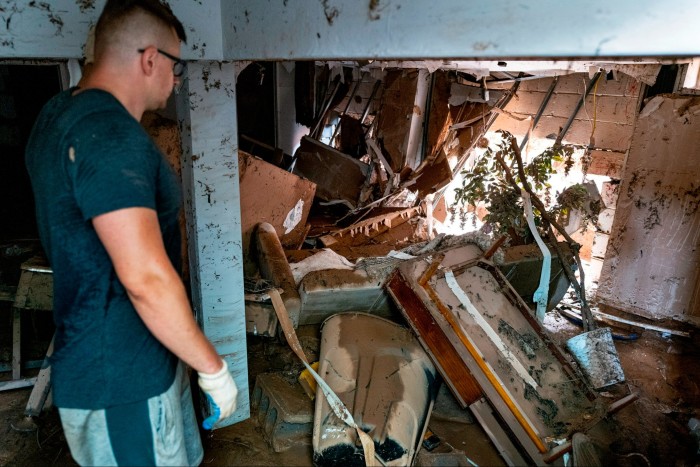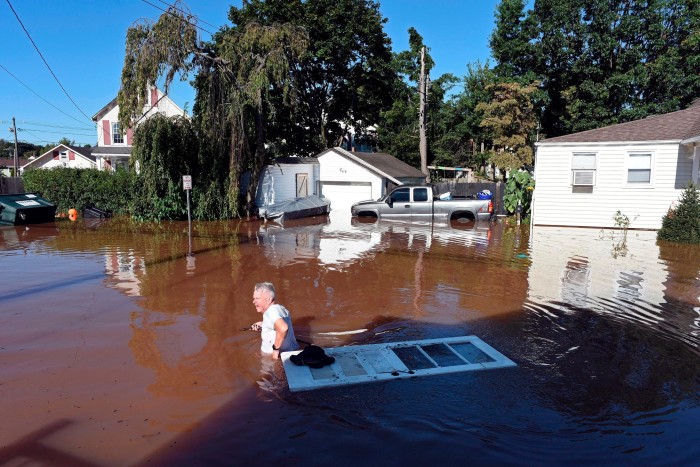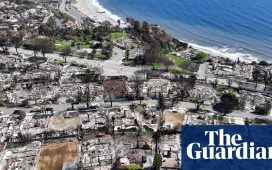Faisal Mairaj knew he was buying a house in a flood zone when he purchased a rental property in Manville, New Jersey, in 2016. But it seemed a chance worth taking: according to the US Federal Emergency Management Agency, the risk of severe flooding was only 1 per cent a year.
Five years later, Hurricane Ida hit. “Ida was really bad — there was over 6 foot of water in the house,” Mairaj says.
Manville, a former manufacturing town of about 11,000 at the confluence of the Raritan and Millstone rivers, has had problems with flooding before. Ida hit it hard, though, inundating homes and prompting a visit from Joe Biden to witness the relief effort in 2021.
The town was built on impervious soil, which means water does not drain away readily, but its problems are part of a crisis unfolding around the world.
As a study in the journal Nature showed last year, the past 30 years have featured more frequent and severe storms, with heavier rainfall, at the same time that property development in flood zones has accelerated.
However, the housing market has been slow to reflect the rising risk. As a result, homes built in flood zones across the US are overvalued by as much as $237bn, according to research by Jesse Gourevitch from sustainability non-profit the Environmental Defense Fund.
One reason is inadequate information to assess US flood risk, Gourevitch says. The flood maps that Fema uses to set premiums for its federally underwritten National Flood Insurance Program — which is how most Americans get flood insurance — are outdated.
“They lack coverage in some places, they’re not forward looking, and they don’t account for climate change, and they don’t account for fluvial flood risk,” explains Gourevitch, referring to when rivers and streams burst their banks.
In addition, many US states — including those most prone to flooding, such as Florida — do not require sellers to disclose a property’s flood risk to buyers.
New Jersey’s problem is too much water to start with — unlike places such as California, which suffer shortages. The sea level at the Jersey Shore has risen about 18 inches since the early 1900s — more than twice the global mean of 8 inches, according to Rutgers University’s Climate Change Resource Centre. But development in the US’s most densely populated state is heavily concentrated near shores and rivers, putting homes and businesses at risk.

That risk is not being factored in to insurance premiums. “The costs associated with flooding are essentially getting socialised, or transferred to taxpayers generally,” Gourevitch says.
Fema’s subsidised rates have been too low to cover the cost of rising flood claims. It currently owes $20.5bn to the US Treasury — and that is after Congress cancelled $16bn in debt in 2017, according to a Congressional report in January.
For several years now, Fema has been moving to a system of risk-based pricing and raising its rates. But, last year, the US Government Accountability Office forecast that median annual premiums would have to double from $689 in 2022 to $1,288 to cover the full risk, warning of “affordability concerns”.
Under the old pricing system, which had not been updated for half a century, premiums rose on average 8 per cent annually. Now, according to an analysis of Fema data by the E&E News website, this doubling of rates will become a reality in 800 of 3,000 counties.
It will be phased in, however, with the GAO expecting 95 cent of current policies to be charging full risk premiums only by 2037.
Fema also estimates that 96 per cent of policyholders will see increases of no more than $20 per month, or will even see decreases. And it says those who do have to pay more will have increases capped at no more than 18 per cent a year, until the full price is reached.
Communities have tried other ways to mitigate the flood risk to their homes, but the costs can be prohibitive.

In 2016, the Army Corps of Engineers concluded that it was not cost-effective to build flood walls, levies and pump stations to protect Manville. It was simpler to knock down the houses at risk, and retreat from the flood plains.
Already, 200 homes have been demolished. Mairaj’s was one of them, in 2022. He accepted an offer to buy his home from Blue Acres, a programme led by the New Jersey Department of Environmental Protection. “It doesn’t make sense for these type of properties to remain because it’s only getting worse,” argues Mairaj.
Blue Acres buys up properties in flood-prone areas and demolishes them to create open space as a buffer zone. Manville plans to knock down another 500 houses. But the buffer means lost property tax revenue. Manville mayor Richard Onderko estimates the town has lost close to $2mn since the programme began almost two decades ago.
Now, further climate factors are adding to the problem. After Hurricane Ida, the town’s residents were told they could apply for federal relief funds to elevate their homes. But, in August last year, New Jersey’s Department of Community Affairs said funds could only be used to buy out properties, as elevation would “not be sufficient for tomorrow’s climate change-driven floods”.
Onderko says he believes the impact of climate, but the real problem is overdevelopment, which causes stormwater from buildings in neighbouring towns to flow into Manville. “They just keep putting in apartment complexes and warehouses all around Manville and all that water comes to us,” he says.
Shawn LaTourette, commissioner of NJDEP, believes the problem is both climate change and bad water management. “We’ve been using out-of-date rainfall predictions in our building standards so our stormwater features are not large enough,” he points out.
LaTourette says the state now insists on forward-looking rainfall data to assess flood risk. In December, it passed a law compelling landlords and sellers to disclose a property’s flood history.
“There is no silver bullet that is going to save Manville or another community from the ravages of climate change,” admits LaTourette. “But there is a network of solutions.”
These range from updating stormwater facilities, to buyouts in some places and new floodwalls in others. In all cases, better planning is needed.
But, in spite of all the obvious risks in Manville, Onderko says that houses are still selling like “hot cakes”.
“There’s a huge housing demand in New Jersey,” he explains. “People are buying these flood homes. They are just taking the risk.”











